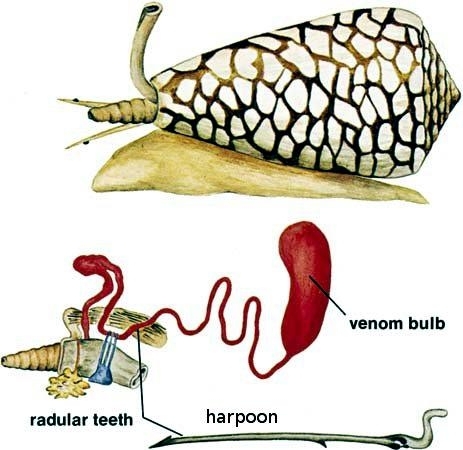

There are around 500 different species of cone shell, with the most venomous producing up to 100 individual toxins, known as conotoxins. The textile cone shell, or the conus textile, harbors a cone snail, with the conus belonging to the conidae family. I would have picked it up bcs it's pretty." Perez thanked him for the warning, writing: "I'm so glad I came across this video, literally don't know a thing about shells. TikToker Maddie admitted: "Now I have a fear of something I didn't even know existed lol." Sharing their own near-miss, JMo357 wrote: "Learned this on a school trip to Hawaii. SeasonĬommenting on the video, Angoose said: "Mans holding death in his hand."
#TEXTILE CONE SNAIL HOW TO#
How to Trap 'Murder Hornets' Ahead of 2021 U.S.


Snake Catcher Shares 'Chaotic' Video of Deadly Serpent in Woman's Bedroom.In the background of the video, Jono can be heard claiming it's his "best find ever," as he handles the shell without gloves, and holds it in his palm. The video, which has been watched more than 17 million times, was captioned: "The oceans safety should be taught in schools." Please do not pick up cone shells without gloves. This animal will kill in less than 9 minutes. In the clip, Jono says: "Back 9 months ago I was nearly killed at the beach. Inside was a cone snail, which is among the "most venomous creatures on earth." The 19-year-old uploaded a clip to TikTok earlier this week, sharing the moment he came inches away from death, after picking up a pretty textile cone. The teenager, identified only as Jono, from Queensland, Australia, is an avid shell collector who regularly heads down to the ocean to search for specimens. Proceedings of the National Academy of Sciences, 112(6): 1743-1748.A teenager has shared his near-death beach experience after picking up one of the world's deadliest animals-which harbors enough venom to kill 700 people. Specialized insulin is used for chemical warfare by fish-hunting cone snails. Safavi-Hemamia, H., Gajewiak, J., Karanth, S., Robinson, S.D., Ueberheide, B., Douglass, A.D., Schlegel, A., Imperial, J.S., Watkins, M., Bandyopadhyay, P.K., Yandell, M., Li, Q., Purcell, A.W., Norton, R.S., Ellgaard, L. Remarkable inter- and intra-species complexity of conotoxins revealed by LC/MS. Museum employees are encouraged to blog about their unique experiences and knowledge gained from working at the museum. Pearce, PhD, is the head of the mollusks section at Carnegie Museum of Natural History. Riddle: What lies at the bottom of the ocean and twitches?

Success could mean an alternative to opioid drugs, and potentially a powerful tool for solving the opioid crisis.įun Fact: Sunken ships provide habitat for many undersea creatures including cone snails. Researchers continue studying ways to get the peptide across the blood-brain barrier. Scattered reports suggest an odd side effect: people who take Prialt hear music in their heads. The FDA approved it in 2004 for end-of-life cases (pain management). However, it doesn’t cross the blood-brain barrier so must be injected directly into spinal fluid. It is more powerful than morphine, not addictive, and people don’t build up a tolerance. Researchers are studying cone snail insulin for ideas to make better insulin for use in humans.Īnother medicine currently used in humans is the pain killer ziconotide (Prialt). The cone snail uses its insulin to immobilize fish by hypoglycemic shock (caused by extremely low blood sugar), making prey easier to catch. In contrast, human insulin is stored as a cluster of six insulin molecules that must separate to become active, and separation can take 60 minutes (or 15-30 minutes for modified human insulin). The cone snail insulin is a single molecule that acts within 5 minutes. Although only about 0.1% of these >50,000 peptides have been characterized, many have already been recognized to have pharmaceutical uses: six for pain, three for cardiovascular issues, one for epilepsy, and one for mood.Ī potentially useful medicine from the venom of fish-eating cone snails is insulin, which acts faster than human insulin. Specimen CM 73476, photo by Tim Pearce.Įach cone snail species produces more than 100 conotoxins, with an estimated 5% overlap in conotoxins among species. Geography cone (Conus geographus), a sea snail with venom powerful enough to kill humans. Those species occur in the South Pacific and Indian Oceans. Of the approximately 600 species of cone snails, two species have killed humans: the geography cone ( Conus geographus) and the textile cone ( Conus textile). These peptides are short proteins, mostly 12-30 amino acids long. Carnivorous and predatory, killer cone snails (genus Conus) stun their prey by injecting peptide neurotoxins called conotoxins.


 0 kommentar(er)
0 kommentar(er)
